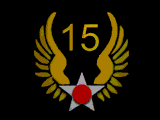|
Chester F. Kingsman, 0-738930, First Lieutenant, Air Corps,
721st Bombardment Squadron (H) 450th Bombardment Group
(H), Army of the United States. For Extraordinary achievement while
participating in aerial flight. Lieutenant Kingsman was a Bombardier on a B-24
type aircraft which was the lead ship in the Wing formation that was scheduled
on a particularly dangerous mission to bomb the ball bearing plant at
Wiener-Newustadt, German (Austria). This high priority target was successfully
bombed by the formation and Lieutenant Kingsman's skill was highly responsible
for terrific amount of damage caused to the entire ball bearing plant. Bad
weather enroute to the target made it necessary to deviate from the previously
briefed course. As the formation approached Yugoslavia, there was a 9/10
undercast. This made precision landfall rather difficult due to previous
maneuvers in order to avoid taking the formation through clouds. When the
formation made landfall at 16,000 feet, enemy anti-aircraft guns caused the
Deputy Group Leader to drop out returning to his home base and flak shattered
the right leg of the tail gunner on the ship in which Lieutenant Kingsman was
riding. Lieutenant Kingsman helped remove the injured tail gunner, gave him
first-aid, and put his leg in a temporary blanket splint as the formation was
still one and half (1 ½) hours away from its target. A successful run was made
on the target despite heavy, accurate, and intense flak, in addition to
numerous enemy fighters. The Navigator noticed that not all the bombs dropped
out even though the Bombardier hit the Salvo handle immediately after the
intervelometer indicated that all bombs had dropped. Lieutenant Kingsman and
the Navigator went into the bombbay to investigate the trouble and found 5-100
pound demolition bombs that had freed themselves from their shackles but had
jammed between the racks in the side of the plane, jamming the elevator and
rudder cables. The vanes on the bombs were spinning from the rush of air
throughout the bomb bay and it was necessary for Lieutenant Kingsman to stand
on the cat-walk at 25,000 feet and hold the vanes in place while the Navigator
bound them steadily with arming wire. One (1) bomb had already armed itself
and, although it was a live bomb, it could not be removed as all five (5) of
them. The fusing vane on the tail of this same bomb had partly come out and was
jammed in the bombbay doors when they were closed. Lieutenant Kingsman,
realizing the slightest jar would cause the live bomb to explode, took the
electrical cord from his heated flying suit along with that of the Navigator
and tied the live bomb in the bombbay in such a manner that if the rest of the
bombs fell, the live bomb would still remain suspended. The Pilot did not have
any elevator or rudder control and it was necessary to steer the ship by the
use of throttles alone. The Pilot, realizing if the bomb exploded that it would
not only destroy his own plane but probably several others flying on his wing,
and as a result, he ordered the formation to proceed on without him in order to
confine the danger of exploding to his ship. After securing the bomb as safely
as possible, Lieutenant Kingsman went to the nose turret where he was
successful, along with the rest of the crew, in warding off wave after wave of
enemy fighters. After reaching his home base, Lieutenant Kingsman, with special
instructions called down by the Fifteenth Air Force to the 47th Wing
Ordnance Officer and relayed to Lieutenant Kingsman via radio, successfully
removed the fuses from the other four (4) bombs. By carefully holding the live
bomb while the Navigator pried loose the other four (4) save bombs, he was
successful in saving the lives of the entire crew and the airplane. By his
courage, resourcefulness, and coolness in an extremely dangerous situation,
Lieutenant Kingsman has reflected great credit upon himself and has upheld the
Highest traditions of the United States Army Air Forces. Residence at
appointment: Maple Hill Avenue, Winchester, New Hampshire.
Above Information provided by Samuel Stein, 721st Squadron
|



